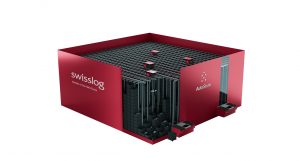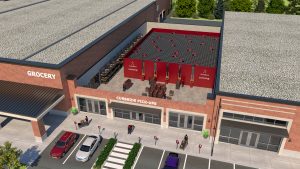Swisslog, one of the global leaders in robotic, data-driven, and flexible automated solutions, participated in Gulfood Manufacturing 2022 – which was hosted in November 2022. The trade fair is the region’s definitive destination to see the future of food production, from advanced technologies to integrated supply chain solutions and ground-breaking innovations propelling the industry ahead.
Highlighting its presence, Swisslog Middle East notably focused on cutting-edge technology solutions that might assist businesses in adapting to changes in manufacturing, distribution, and retailing as well as the automation of the food supply chain. Additionally, the attendees were also assisted by Swisslog’s automation specialists in choosing the appropriate automation approach for their vertical farming endeavours and identifying the automation technology required for their operations.
Emphasising advancing vertical farming, David Dronfield, General Manager at Swisslog Middle East, says, “The emergence of indoor vertical farming as a potential solution to growing food capacity more sustainably has been quite evident. Vertical farming can reduce space requirements, water consumption and fertiliser use by up to 99% while eliminating the need for chemical pesticides. This approach is already being used to support the production of fresh greens such as lettuce and herbs, but a broad range of popular produce products could be grown in vertical farms.”

Additionally, the operation of this model is also affected by automation, which means that early adopters of vertical farming have already experimented with it and found that it may effectively enable increased space utilisation and optimise vertical farming procedures. Automation, then, is a critical innovation for logistics organisations. Whether due to post-COVID developments or the industry-disrupting waves, automation has brought about an influence that has been much more noticeable and put into practice.
Companies must be careful to avoid just incorporating automation into anything and everything. A successful supply chain operation comprises the right product, location, and technique. A lack of knowledge of these subjects has put businesses in predicaments where the best course of action may not be available, making it crucial for companies to comprehend the key relevance.
“We have our parent company, KUKA Group, heavily into the automation, the robotics, the assembly line automation, so we are working closely with them. However, we are also looking into tap into essential industries and not just every industry, but the ones which are vital to the population and the linked businesses,” adds David.
Similarly, automation is already being used in food distribution but must adapt to changes in production and retailing. Here are three ways that the food supply chain will likely become more automated: MFC-ready distribution, urban distribution, and adequate cold storage.
First of all, food distribution centres (FDCs) are already getting ready to facilitate more effective store replenishment using robotic palletising technologies that can produce pallets prepared for the aisles for more effective replenishing. Building micro fulfilment centre (MFC) ready bins, which allow for more effective robotic replenishment, is the next stage in this progression. Instead of unpacking and bin loading at the MFC, shuttle systems can be used to create automation-ready bins at the DC. The delivery of automation-ready bins to each MFC by the DC is made possible by the MFCs’ software interface to the DC based on current inventory levels.

Second, as the population grows, severe challenges within the food supply chain have surfaced – traffic congestion and regulations that limit delivery frequency, necessitating the use of automated urban distribution centres. However, doing this will be made possible through automation. Additionally, it is possible to build adaptable and quickly deployable urban distribution centres customised to specific markets’ needs by using small, containerised automation modules.
Lastly, supplying a rising population with food will depend on a solid cold chain. More vertical cold storage is made possible by automation, and when combined with advanced energy management techniques, these settings can enable greater energy efficiency within the environments.
Not to mention, it is crucial to recognise that industries are still recovering from the pandemic’s impact. The lockdowns caused by COVID-19 and as a result had a significant effect on the food and beverage industry. The industry is expected to develop at a compound annual growth rate of 3.6% between 2019 and 2024, according to Interact Analysis. This is greater than the industry’s average annual growth rate over the preceding five years, which was 3.5%.
But in this demanding climate, success depends on adaptability, effectiveness, and quality. It has become clear that manual methods cannot provide the profitability and scalability that food producers need to expand their companies. Swisslog’s team demonstrated a cohesive ecosystem at Gulfood that integrates food production, in-person and online sales, and trash recycling.
Considering the future of logistics and Swisslog, David stated, “The industry is going to be very highly automated, not just because people can learn about it on YouTube, but because there is a huge demand for it. The current generation prefers automated, faster, sustainable, and easier options – resulting in higher demand. Fitting right in here, Swisslog is planning to make the necessary changes that will suit the company to thrive and make wiser business decisions. Correspondingly, the future will be economical, sustainable, and robotically driven on bigger perspectives.”

